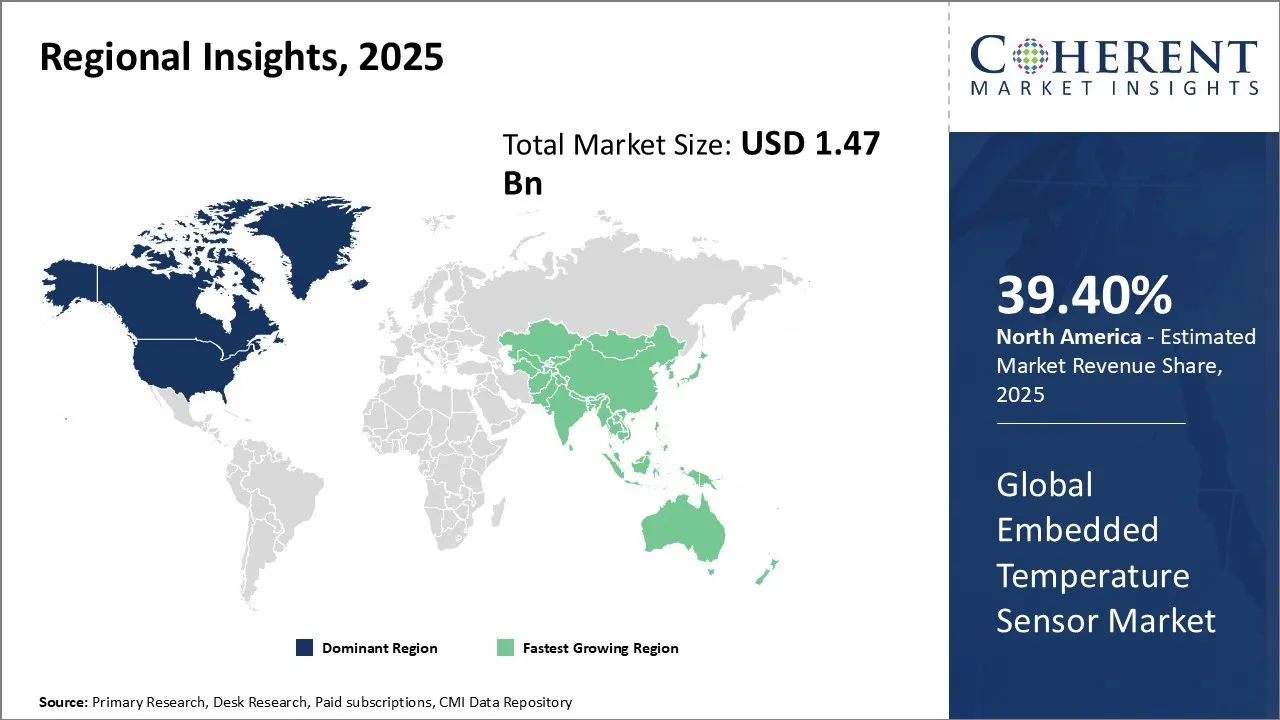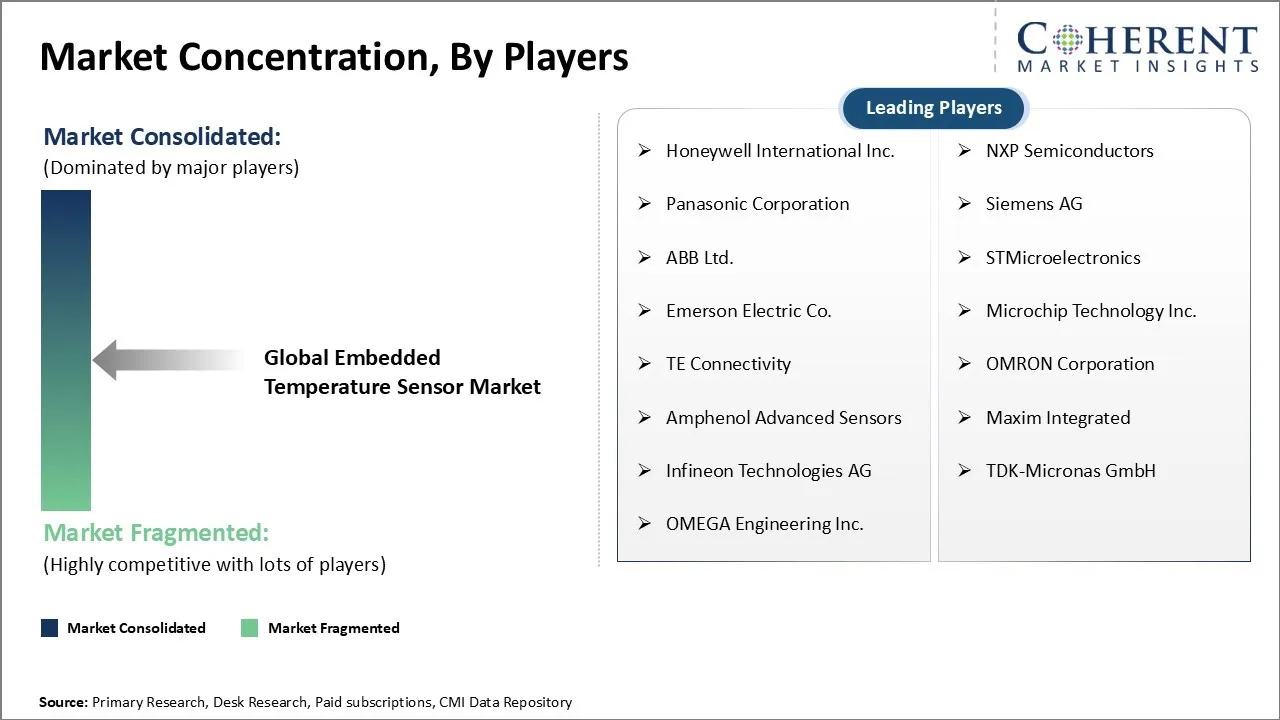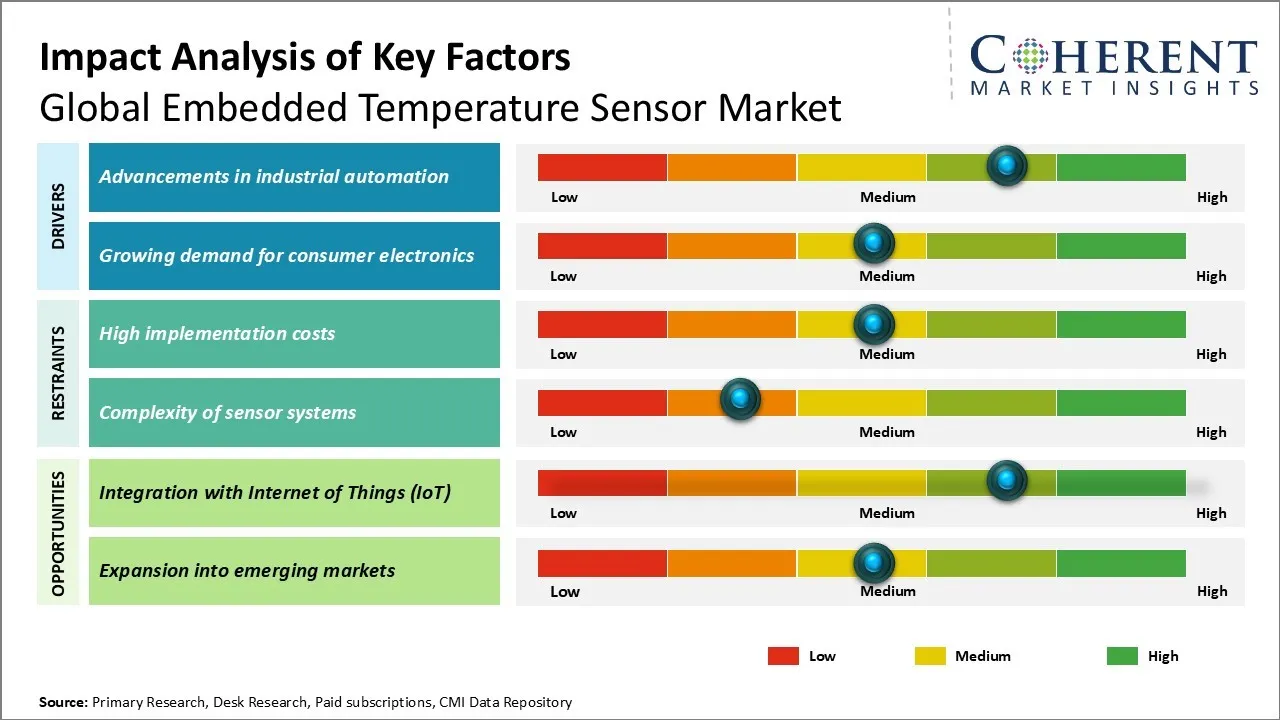
The Global Embedded Temperature Sensor Market is estimated to be valued at USD 1.47 Bn in 2025 and is expected to reach USD 3.01 Bn by 2032, exhibiting a compound annual growth rate (CAGR) of 10.8% from 2025 to 2032.
Key Takeaways of the Embedded Temperature Sensor Market:
Market Overview:
The embedded temperature sensor market growth is being driven by the growing demand for real-time temperature monitoring across various industries. Embedded temperature sensors are being increasingly used for monitoring vital signs in the healthcare sector. Furthermore, wide applications of temperature sensors in automotive electronics, industrial equipment, and home appliances is fostering the demand for embedded temperature sensors. Advancements in sensor technologies have improved accuracy and reduced the size of embedded temperature sensors. This has further expanded their scope of applications. Development of smart cities infrastructure and rising adoption of IoT devices are also driving the growth of the embedded temperature sensor market.
Type Insights - Contact Sensors Dominate the Market, Offering Reliable Measurements
The contact sensors segment is expected to contribute the largest share of 65.3% in the global embedded temperature sensor market in 2025 due to their ability to provide precise and reliable temperature readings. These sensors measure temperature by coming into direct physical contact with the object or substance being tested. This contact-based measurement allows contact sensors to achieve very high accuracy, often within ±0.1°C.
Contact sensors are well-suited for applications where an exact temperature reading is critical such as in industries like manufacturing and medical equipment. Their precision enables manufacturers to closely monitor production processes and quality control steps and make real-time adjustments if any temperature deviations occur. In healthcare, contact sensors allow medical devices like incubators and surgical equipment to maintain highly specific temperature settings that patients rely on.
The durable construction of contact sensors also makes them a popular choice when temperature measurement must occur in harsh environments or over long periods. Their encased design protects the sensing component from outside interference or damage. As a result, contact sensors tend to have longer operational lifespans than alternatives like infrared non-contact sensors. This durability reduces maintenance and replacement costs for equipment operators.
Contact sensors' strength in accuracy-critical and harsh conditions means they remain the technology of choice for many core temperature measurement roles. This drives their continued largest market share compared to other types. Going forward, refinements to contact sensor technology aim to push measurement precision even higher to +/- 0.01°C, capturing more temperature variation data to help optimize processes.
Application Insights – The Chemicals Sector Creates Substantial Demand for Embedded Temperature Sensors for Process Monitoring
The chemicals segment is expected to account for the highest share of 22.6% in the embedded temperature sensor market in 2025 among application sectors. Precise temperature control and monitoring are essential throughout chemical production and processing to ensure safety, quality, and efficiency.
Embedded temperature sensors help chemical companies meet strict regulatory standards by tracking temperature in all stages of manufacturing from reactor vessels to storage tanks. Detecting any unsafe temperature deviations quickly allows issues to be addressed before accidents occur. Sensors also aid process optimization by feeding real-time temperature data back to control systems.
Measurements from embedded sensors within heat transfer applications help synthetic fiber and plastic producers precisely regulate heating elements. This temperature visibility minimizes wasted energy and material costs from over- or under-heating. Sensors embedded in packing and distribution equipment further help chemical firms meet distribution temperature specifications for refrigerated or heated goods.
Additionally, many chemical reactions are temperature-dependent, requiring tight regulation. Embedded temperature monitoring inside reactors and synthesis equipment helps producers optimize yields and throughput. Any variances from ideal reaction temperatures can be immediately compensated for.
Given these myriad monitoring needs, the large and regulated chemicals industry has come to heavily rely on embedded temperature sensors. This need drives its leadership position among industries for embedded temperature sensor demand.

Need a Different Region or Segment? Download Free Sample
North America Embedded Temperature Sensor Market Trends
North America leads the market with an estimated share of 39.4% in 2025. This dominance can be attributed to the strong presence of established sensor manufacturers as well as leading semiconductor companies in the region. Countries such as the U.S. and Canada have a highly developed industrial sector with a focus on automation and IoT, driving the need for advanced embedded temperature sensors.
Asia Pacific Embedded Temperature Sensor Market Trends
The Asia Pacific region is projected to hold a share of 24.7% in 2025 and exhibit the fastest growth in the embedded temperature sensor market. Several factors such as rising electronics and semiconductor manufacturing in countries like China, Japan, South Korea, and Taiwan are fueling the demand. Additionally, the growth of connected devices in Southeast Asian countries and government initiatives to develop smart infrastructure are boosting the market growth.
Embedded Temperature Sensor Market Outlook for Key Countries
U.S. Embedded Temperature Sensor Market Trends
The U.S. embedded temperature sensor market remains a leader in technological advancements, driven by strong investments in research and development (R&D), industrial automation, and consumer electronics. The market benefits from a well-established semiconductor industry, fostering innovation in high-precision and miniaturized sensor solutions. Major players such as Analog Devices, Texas Instruments, Honeywell, and TE Connectivity continue to dominate, offering integrated sensor solutions tailored for applications in automotive, healthcare, and industrial automation. Local players, including Maxim Integrated and Amphenol Advanced Sensors, are contributing to market expansion by developing highly efficient temperature sensors with improved sensitivity and faster response times.
China Embedded Temperature Sensor Market Trends
China embedded temperature sensor market is witnessing rapid growth, fueled by the country's dominance as a global electronics manufacturing hub. The market benefits from strong government support, growing industrial automation, and high demand for consumer electronics. The Made in China 2025 initiative, which focuses on increasing domestic semiconductor production, has significantly boosted local sensor manufacturers, reducing reliance on foreign imports.
Leading local players such as TDK, Microchip, and Shanghai Aerospace Electronics are at the forefront of innovation, supplying sensors for applications in smartphones, electric vehicles (EVs), and industrial automation.
Japan Embedded Temperature Sensor Market Trends
Japan maintains its position as a leader in the embedded temperature sensor market, driven by technological innovation and miniaturization advancements. The country's expertise in precision manufacturing and semiconductor technology allows for the development of high-performance, intelligent, and energy-efficient sensors used in applications ranging from automotive electronics to medical devices. Industry giants such as Murata, Omron, and Rohm Semiconductor are spearheading sensor developments, focusing on miniaturized and high-accuracy temperature sensors for industrial automation, robotics, and smart wearables.
Germany Embedded Temperature Sensor Market Trends
Germany embedded temperature sensor market is strongly supported by the country’s well-established automotive and industrial manufacturing sectors. The rise of smart manufacturing, Industry 4.0, and automation have propelled the demand for highly precise and rugged temperature sensors used in critical applications such as robotics, power systems, and automotive safety. Global leaders such as Bosch, Infineon Technologies, and Siemens are at the forefront of sensor innovation, particularly in the automotive sector.

Get actionable strategies to beat competition: Download Free Sample
Key Developments:
Top Strategies Followed by Global Embedded Temperature Sensor Market Players
Emerging Startups - Embedded Temperature Sensor Industry Ecosystem
Embedded Temperature Sensor Market Report Coverage
| Report Coverage | Details | ||
|---|---|---|---|
| Base Year: | 2024 | Market Size in 2025: | US$ 1.47 Bn |
| Historical Data for: | 2020 To 2024 | Forecast Period: | 2025 To 2032 |
| Forecast Period 2025 to 2032 CAGR: | 10.8% | 2032 Value Projection: | US$ 3.01 Bn |
| Geographies covered: |
|
||
| Segments covered: |
|
||
| Companies covered: |
Honeywell International Inc., NXP Semiconductors, Panasonic Corporation, Siemens AG, ABB Ltd., STMicroelectronics, Emerson Electric Co., Microchip Technology Inc., TE Connectivity, OMRON Corporation, Amphenol Advanced Sensors, Maxim Integrated, Infineon Technologies AG, TDK-Micronas GmbH, and OMEGA Engineering Inc. |
||
| Growth Drivers: |
|
||
| Restraints & Challenges: |
|
||
Uncover macros and micros vetted on 75+ parameters: Get instant access to report

Discover market dynamics shaping the industry: Download Free Sample
Embedded Temperature Sensor Market Driver - Advancements in industrial automation
The rise of Industry 4.0 and increasing digitization of processes across industries have led to significant advancements in industrial automation over the past decade. Manufacturers are automating more of their production lines and integrating various sensors and other IoT technologies to obtain real-time data from operations. This allows them to closely monitor processes, detect issues, analyze performance, and take corrective actions. Embedded temperature sensors play a vital role in industrial automation due to their ability to precisely measure temperature under different environmental conditions within manufacturing facilities, machinery, equipment, and other industrial assets.
Temperature monitoring is critical in industrial operations to ensure quality control and compliance with safety standards. Even small temperature variations can affect the performance of different systems. Embedded temperature sensors allow continuous monitoring of temperature levels across the production floor and in strategic areas such as control rooms, servers, and electrical panels. The data collected helps identify temperature anomalies and hotspots early on to prevent equipment damage or failures. It also helps optimize processes by incorporating temperature data into predictive maintenance programs. Many industries dealing with hazardous materials also rely on embedded temperature sensors to track shipments in cold supply chains and detect overheating of containers to mitigate risks.
Advancements in sensor technology have enabled the development of more compact, rugged, and intelligent sensors that can withstand harsh industrial environments. Sensors with longer lifespans, enhanced accuracy, and wireless connectivity options are seeing higher demand. This allows integrating sensors seamlessly into new and existing automated systems with minimal downtime. It has boosted applications of temperature monitoring in areas that were difficult to access previously such as moving machinery parts. The demand for sensors with advanced analytics and edge computing capabilities is also increasing as manufacturers look to utilize real-time big data for advanced process control, quality management and predictive alerts. With continued industrial digitization efforts, embedded temperature sensors will play a critical role in enabling predictive maintenance approaches and the overall vision of smart factories of the future.
Embedded Temperature Sensor Market Challenge - High implementation costs
One of the key challenges hindering the growth of the global embedded temperature sensor market is the high implementation costs associated with integrating temperature sensors into connected devices. Developing advanced temperature sensing solutions capable of meeting strict accuracy and reliability specifications requires extensive research and development expenditures. Manufacturers also have to invest heavily in testing and validation procedures to ensure the quality and durability of embedded sensors. The costs are further increased due to requirements such as high-grade material selection, precision engineering, and miniaturization. Added to this are the expenses on production tooling, sensor packaging, and calibration processes. All these factors contribute to elevated product costs, restricting mass adoption rates especially in cost-sensitive applications. To tackle this issue, vendors need to optimize design architectures, leverage the latest fabrication technologies and streamline manufacturing workflows to reduce overall component costs without compromising on performance.
Embedded Temperature Sensor Market Opportunity - Integration with Internet of Things (IoT)
The rising prevalence of IoT platforms and connected devices represents a major growth opportunity for embedded temperature sensor providers. As more ‘things’ across various industry verticals get networked through IoT infrastructures, there will be manifold increase in the number of nodes requiring real-time temperature monitoring capabilities. The integration of temperature sensing ICs and modules with IoT gateways and edge devices enables remote condition monitoring and predictive maintenance capabilities. OEMs can offer differentiated services through data-driven insights gleaned from sensor measurements. This helps improve operational efficiencies, optimize asset utilization and reduce downtimes. IoT also facilitates over-the-air upgrades that enable extending the functional lifespan of embedded sensors. Furthermore, cloud-based sensor data analytics unlocks opportunities in applications such as equipment health monitoring, supply chain management and smart city infrastructure management. Leveraging IoT connectivity can thus help embedded temperature sensor manufacturers capture new revenue streams and expand into lucrative application ecosystems.
Share
Share
About Author
As an accomplished Senior Consultant with 7+ years of experience, Pooja Tayade has a proven track record in devising and implementing data and strategy consulting across various industries. She specializes in market research, competitive analysis, primary insights, and market estimation. She excels in strategic advisory, delivering data-driven insights to help clients navigate market complexities, optimize entry strategies, and achieve sustainable growth.
Missing comfort of reading report in your local language? Find your preferred language :
Transform your Strategy with Exclusive Trending Reports :
Frequently Asked Questions
Joining thousands of companies around the world committed to making the Excellent Business Solutions.
View All Our Clients